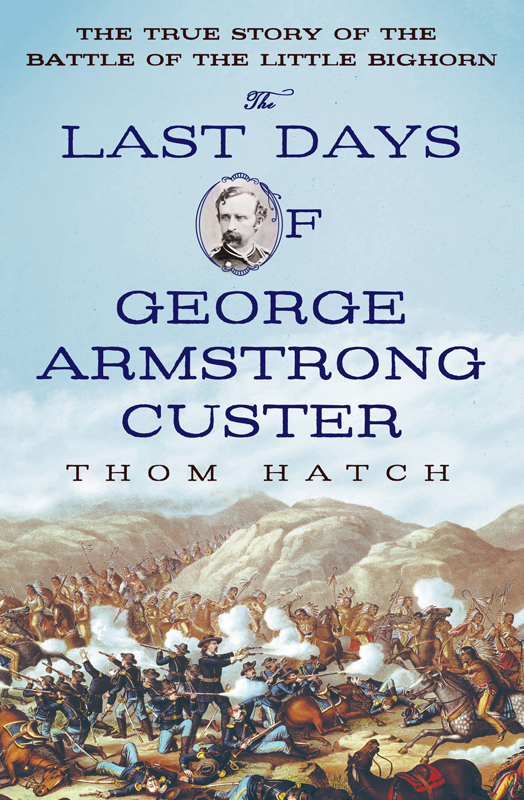
The Last Days of George Armstrong Custer
The True Story of the Battle of the Little Bighorn
کتاب های مرتبط
- اطلاعات
- نقد و بررسی
- دیدگاه کاربران
نقد و بررسی

December 15, 2014
Most historians blame Custer for the 1876 massacre, but this energetic, intensely researched, and eccentric account from Hatch (The Last Outlaws) concludes that he was blameless. The author focuses on the years following 1874, when the Lakota Sioux refused to leave their Black Hills reservation after gold was discovered. Determined to eject them, several army units converged on what turned out to be a huge Sioux encampment. Arriving first, Custer split his regiment into three columns, a sensible tactic according to Hatch, to prevent their escape (as Custer was ordered). The first unit disobeyed his order to charge; the others disobeyed orders to join their commander after he was attacked. With Custer dead, the surviving commanders and superior officers hastened to blame him, and historians agree that the official inquiry was a cover-up. Hatch takes the bizarre position that the U.S. “had every right to expand its boundaries to include the Great Plains West” and disapproves of the Sioux’s violence in defending their land—which, he maintains, warranted military intervention to “restore peace.” Readers may find this unsettling (and arguably racist), but they will agree that he makes a reasonable case for Custer’s competence.

December 15, 2014
Revisionist study of one of the most signal defeats in the annals of America. By Hatch's (Glorious War: The Civil War Adventures of George Armstrong Custer, 2013, etc.) account, it is an enduring myth to think that Custer committed a mistake by splitting his forces and entering the field of battle on the grass of Little Bighorn in multiple columns. In previous engagements in the Civil War and Indian Wars, Custer had separated his command and lived to tell the tale, once at the Battle of the Washita River. Hatch does not add that at Washita it was mostly women and children who stood in Custer's way, though the warriors managed to rub out one of those separated units, but his point stands: Viewing the lay of the land and where he thought his enemies were and how they would react, Custer was rightly engaging in a strategy that he had proven in past battles. In a library that includes work by such fine writers as Nathaniel Philbrick and Evan S. Connell, Hatch's book is no competition in literary terms; the prose sags and strains ("the powers that be did not have to work too hard to demonize the Sioux and Cheyenne in the eyes of the average cavalryman"). As a purely military account that draws heavily on that library, though, it has its merits. Hatch does a good job of describing firearms, tactics, the minutiae of cavalry mounts and the terrible fury of a battle that might have been won had Marcus Reno's and Frederick Benteen's columns arrived. To his detriment, though, Hatch goes on too long about "brotherhood under fire," a sentiment the victorious Indians no doubt felt themselves. The author's nonironic contrasting of the "civilized world" with theirs is something at home in Custer's era but not in our own. Custer completists will want to have a look, but there are many better books on the subject.
COPYRIGHT(2014) Kirkus Reviews, ALL RIGHTS RESERVED.

January 1, 2015
The Battle of the Little Big Horn, fought on June 25th and 26th, 1876, is one of the most decisive defeats ever suffered by the U.S. Army. The Seventh Cavalry saw more than 40 percent of its troops killed--including its flamboyant commander, Lieutenant Colonel George Armstrong Custer--by a unified force of Cheyenne and Sioux warriors. Hatch (Osceola and the Great Seminole War) contends that, despite the outcome, Custer's plan of attack in the battle was the work of a tactical genius and should have succeeded. In his view, Custer was one of the transcendent figures of his age whose brilliance was undercut by his subordinates. The hyperbole about Custer in this "true story" makes this mostly a one-sided account, especially since many of the sources utilized were produced by the Seventh Cavalry's survivors and their sympathetic biographers. Given short shrift are the Sioux and Cheyenne narratives that paint a very different picture of the battle. VERDICT Readers should instead consider both Tim Lehman's Bloodshed at Little Bighorn: Sitting Bull, Custer, and the Destinies of Nations and Uncovering History: Archaeological Investigations at the Little Bighorn by Douglas D. Scott.--John R. Burch, Campbellsville Univ. Lib., KY
Copyright 2015 Library Journal, LLC Used with permission.

























دیدگاه کاربران